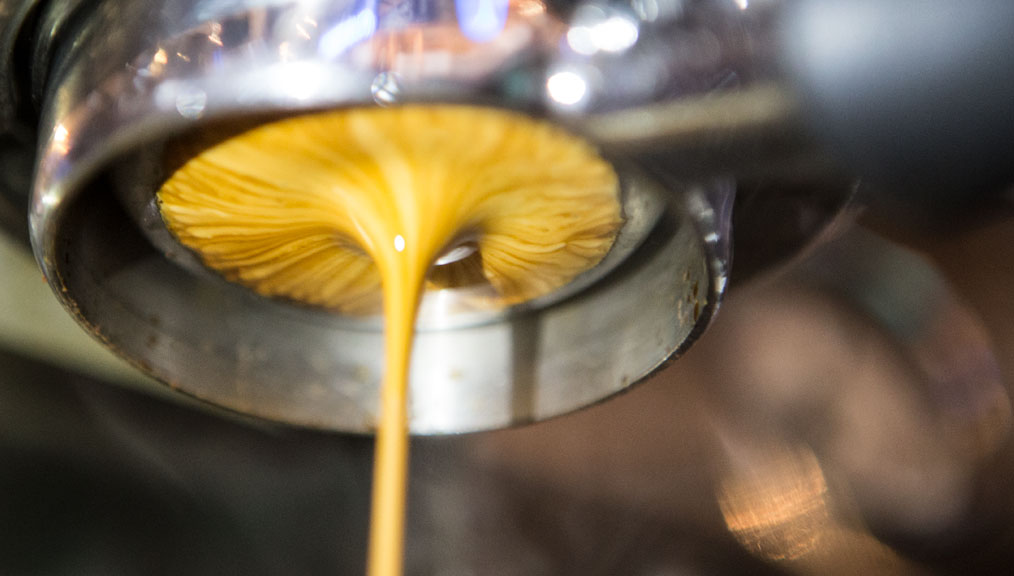(Photo: Cory Eldridge.)
[C]offee is, simply, a beverage made by using water to extract compounds from roasted coffee beans. Some of these compounds are hydrophilic and readily dissolve in water, but some are hydrophobic and don’t want to dissolve as easily. These hydrophobic molecules solvate like oil in water; in coffee, they provide texture, or are entirely excluded from the water as aroma.
The methods of preparing coffee can be categorized by how they deal with these compounds. Instant coffee tries to capture them, but they are typically lost in the dehydration process, where cold-brew uses patience to extract them, but has to combat the long evaporation period that accompanies a long brew time. Drip and filter coffee use high temperature to access hydrophobic compounds, while espresso uses high temperature and high pressure to speed this process up and—at least initially—confine the aromatics into the espresso shot.
But the question is, how much pressure do you really need? Depends on who you ask. Historically, the industry standard has been nine bar of pressure.
Baristas have been experimenting with pressure for decades: lever machines put pressure at the mercy of the barista’s biomechanics, and more sophisticated pressure-profiling machines allow controlled manipulation of both temperature and pressure. Despite these technological advances, it is becoming more popular to experiment with line pressure (the pressure coming in from your municipal water line); with no standard for line pressure, values can vary widely by city.
This prompts another practical question: how much can you manipulate pressure until you no longer have, in a strict sense, espresso?
Our takeaway is that all coffee beverages lie on a continuum. Espresso is uniquely situated in that we get to manipulate not only grind and temperature, but also pressure. But pressure modifications are more of a dark art than, say, up-dosing or pulling a shorter shot.
An interesting example is the Swiss caffè crema, which falls on a gray area of the spectrum between what we think of as drip and espresso. Coarsely ground coffee is lightly packed into a portafilter, from which a six- to nine-ounce beverage is yielded. Generally speaking, espresso machines are designed to offer nine bar of pressure as a maximum condition. If the coffee cannot offer resistance to the machine, as is the case with caffè crema, there will be little or no pressure generated. While the drink is produced from a modern espresso machine, the coffee isn’t experiencing the high pressure of a traditional espresso. The resulting drink, though, is not fundamentally different from an espresso in how it was made.
Pressure modifications are more of a dark art than, say, up-dosing or pulling a shorter shot.
Espresso is unique in that high extractions are required in short time periods. This requires a grind finer than filter coffee to provide the appropriate resistance for the water. You can think of the coffee and portafilter like a resistor in an otherwise free flowing channel of water. Hence, higher pressure usually mandates finer grinding to mechanically achieve a tasty beverage. (Finer grinds pack more densely, making it more difficult for water to pass through, in turn facilitating more surface interaction to extract flavor compounds.)
Aside from this important mechanical role, there are other plausible hypotheses about the role of pressure in extraction. One is that pressure alone increases the extraction rate. Another is that it has a physical effect on the texture of the brew; particularly appealing is the idea that it makes the crema foamier. The presence of pressure helps dissolve desirable fats and oils (hydrophobic compounds) from the grounds, a requirement given the very short brew times. Higher pressure espresso tends to display larger bubbles in the crema that settle to the top like a tiny pour of stout beer, while lower pressure offers finer, silkier bubbles that settle quickly. This could be due to the flow rate out of the portafilter, or it could be due to the chemical makeup of the coffee: work still needs to be done here.
Assuming we’re right, the major differences you’d expect to see between low-pressure (two to five bar) and high-pressure (nine bar and above) extraction have more to do with the other variables—the grind, time, and temperature. We then return to a central question in coffee: what tastes better? Well, low-pressure espresso shots typically have longer water and coffee contact time, yielding an increase in solvation of everything: yields go up, for better or worse. It is coffee dependent and the recipe needs to be adjusted accordingly.
In our experience, line-pressure espresso isn’t better or worse than nine-bar espresso. Line pressure may vary depending on your source of water and the plumbing in your building; in the worst case, you might find that it changes from day-to-day. On the other hand, it may be a more consistent source of pressure than the pump in your espresso machine, and it’s definitely quieter. Like everything else, this is about your taste: pay attention to what you’re brewing, be systematic, and enjoy.
Ali Mohammad and Ethan Miller put their science and engineering brains to work at Nuli coffee developing espresso technology.















